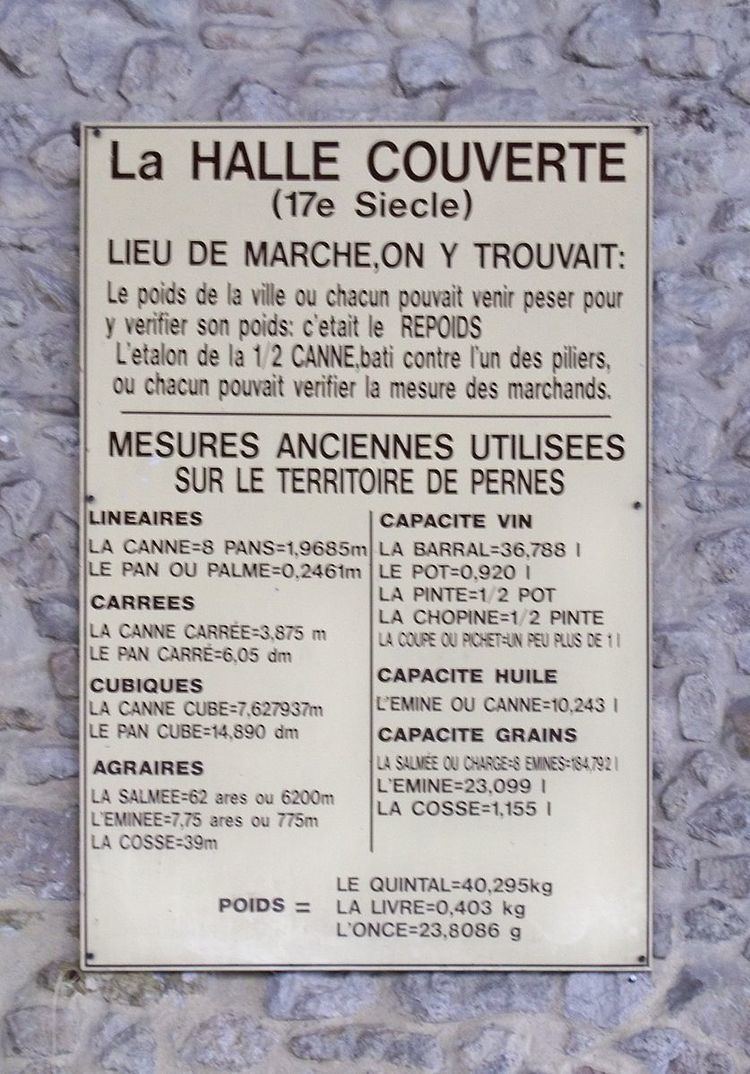 | ||
Before the French Revolution, which started in 1789, French units of measurement were based on the Carolingian system, introduced by the first Holy Roman Emperor Charlemagne (800 – 814 AD) which in turn were based on ancient Roman measures. Charlemagne brought a consistent system of measures across the entire empire. However, after his death the empire fragmented and many rulers introduced their own variants of the units of measure.
Contents
Some of Charlemagne's units of measure, such as the pied du roi (the king's foot) remained virtually unchanged for about a thousand years, while others, such as the aune (ell—used to measure cloth) and the livre (pound) varied dramatically from locality to locality. By the time of the revolution, the number of units of measure had grown to the extent that it was almost impossible to keep track of them.
History
Although the pre-revolutionary era (before 1795) when France used a system of measures that had many of the characteristics of the Imperial System of units, there was no unified system of measurement in France. Whereas in England the Magna Carta decreed that "there shall be one unit of measure throughout the realm", Charlemagne and successive kings had tried but failed to impose a unified system of measurement in France.
The names and relationships of many units of measure were adopted from Roman units of measure and many more were added – it has been estimated that there were seven or eight hundred different names for the various units of measure. Moreover, the quantity associated with each unit of measure differed from town to town and even from trade to trade to the extent that the lieue (league) could vary from 3.268 km in Beauce to 5.849 km in Provence. It has been estimated that on the eve of the Revolution a quarter of a million different units of measure were in use in France. Although certain standards, such as the pied du roi (the King's foot) had a degree of pre-eminence and were used by savants, many traders chose to use their own measuring devices giving scope for fraud and hindering commerce and industry.
As an example, the weights and measures used at Pernes-les-Fontaines in south eastern France differ from those catalogued later in this article as having been used in Paris. In many cases the names are different, while the livre is shown as being 403 g, as opposed to 489 g – the value of the livre du roi.
Tables of units of measure
These definitions use the Paris definitions for the coutume of Paris, and definitions for other Ancien régime civil jurisdictions varied, at times quite significantly.
Length
The mediaeval royal units of length were based on the toise and in particular the toise de l'Écritoire, the distance between the fingertips of the outstretched arms of a man which was introduced in 790 AD by Charlemagne. The toise had 6 pieds (feet) each of 326.6 mm (12.86 in). In 1668 the reference standard was found to have been deformed and it was replaced by the toise du Châtelet which, to accommodate the deformation of the earlier standard, was 11 mm (0.55%) shorter. In 1747 this toise was replaced by a new toise of near-identical length – the Toise du Pérou, custody of which was given to l'Académie des Sciences au Louvre.
Although the pouce (inch), pied (foot) and toise (fathom) were fairly consistent throughout most of pre-revolutionary France, some areas had local variants of the toise. Other units of measure such as the aune (ell), the perche (perch/rood), the arpent and the lieue (league) had a number of variations, particularly the aune (which was used to measure cloth
The loi du 19 frimaire an VIII (Law of 10 December 1799) states that one decimal metre is exactly 443.296 French lines, or 3 pieds 11.296 lignes de la "Toise du Pérou". Thus the French royal foot is exactly 9000/27,706 metres (about 0.3248 m).
In Quebec, the surveys in French units were converted using the relationship 1 pied (of the French variety, the same word being used for English feet as well) = 12.789 English inches. This makes the Quebec pied very slightly smaller (about 4 parts in one million) than the pied used in France.
Mass
According to the law of 19 Frimaire An VIII (December 10, 1799),
Traditionally, the French pound (livre) was defined as the mass of exactly 1⁄70 of a French cubic foot of water. When the kilogramme was defined, knowledge that a pied du roi cube filled with water masses exactly 70 French pounds was apparently lost. According to the traditional (cubic foot) definition, one livre would have been about 489.675 grammes. According to the kilogramme definition, one livre was about 489.506 grammes. The difference is about 0.035%. However, a small difference in salinity (i.e. the difference between distilled water and very good quality drinking water) is enough to explain this difference.
The units in the following table are (except for the talent) calculated based on the kilogramme definition of the livre.
